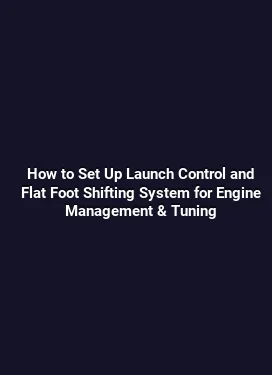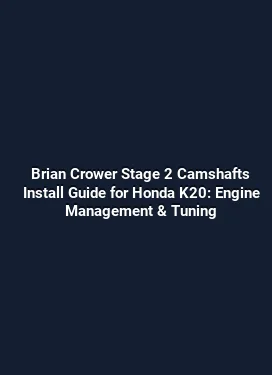Best Fuel Trims for Idle Stability in Modified Engine Setups
Modified engines bring unique challenges when maintaining a steady idle. Changes to displacement, compression, forced induction, cam profiles, and exhaust paths can alter air-fuel dynamics enough to destabilize idle. A nuanced approach to fuel trims—adjustments the engine control unit (ECU) makes to the baseline fuel map in response to real-time sensor data—can restore smoothness without compromising performance, fuel economy, or emissions. This article delves into practical, hands-on strategies for selecting and tuning fuel trims in a variety of modified setups, backed by diagnostic workflows and real-world examples.
Understanding Idle Instability in Modified Setups

Idle stability hinges on maintaining a delicate balance between air entering the engine and the amount of fuel delivered to ignite it. When a modification changes the volumetric efficiency or air timing, the original fueling strategy may no longer align with actual conditions at idle. Common sources of instability include vacuum leaks around intake manifolds or turbocharger blow-off valves, altered throttle body airflow, and shifts in manifold pressure during transient events like A/C cycling or deceleration. The goal is to keep the air-fuel mixture close to stoichiometry at idle, while allowing adaptive corrections to handle minor perturbations gracefully.
In turbocharged or supercharged builds, idle demands can spike due to boost management strategies that bleed back pressure or linger exhaust gas flow. Naturally aspirated engines with aggressive cams may experience longer intake runner effects, leading to richer or leaner trims during warm-up or when transitioning from closed to open throttle. A structured diagnostic approach helps distinguish between transient sensor reading quirks and genuine fuel trim needs.
Fuel Trim Basics in the Context of Modifications
Fuel trims are adjustments made by the ECU to the base fuel map to compensate for deviations observed via critical sensors, primarily the oxygen sensors. Short-term trims address immediate fluctuations on a per-cycle basis, while long-term trims accumulate over longer periods to reflect persistent conditions. In a well-tuned system, short-term corrections should quickly settle as the long-term trend moves toward a stable value. For modified engines, the initial baseline often needs recalibration, followed by a period of cautious learning to avoid overcompensation during transient events.
When working with idle, the most informative signals come from the idle air control path, manifold absolute pressure readings, and, increasingly, direct fuel pressure data. Each modification can influence one or more of these signals. For instance, a lift in mechanical compression or a change in exhaust backpressure can shift the engine’s idle vacuum, prompting the ECU to adjust trims. The objective is to establish a robust idle that remains resilient across climate variations, electrical load changes, and wear-related drift without inducing sudden surges or stumbles.
Harmonizing Baseline Maps with Real-World Conditions

Baseline fuel maps are designed around idealized operating conditions. In a modified engine, the deviation from those conditions is common enough to warrant a methodical re-baselining process. Start by collecting data across several steady-state idle points at different engine temperatures, then identify persistent long-term trim values that settle around a consistent range. This range becomes the new anchor for idle fuel delivery. During this re-baselining, ensure that trims respond gradually to temperature and load changes to avoid oscillations when electrical accessories cycle on and off.
Once a solid baseline is established, use controlled, incremental tests to observe how trims behave during small perturbations. For example, apply a brief, controlled accessory load (like engaging the headlights or rear window defroster) and monitor the resulting trim response. A smooth, proportional responses indicate a healthy adaptive system; abrupt jumps may point to sensor noise, vacuum leaks, or valve timing quirks that require separate addressing.
Sensor Roles and Their Influence on Idle Fuel Trims
Several sensors play pivotal roles in idle fuel trim dynamics. Oxygen sensors provide feedback on combustion efficiency, while mass or volume air flow sensors inform the ECU about the actual air entering the engine. Manifold pressure sensors, cam/crank position sensors, and fuel pressure sensors round out the data set the ECU uses to refine trims. In modified engines, sensor behavior can diverge from stock expectations due to altered intake geometry, forced induction, or exhaust changes. Understanding how each sensor contributes allows for precise, stable trimming without chasing symptoms later.
The oxygen sensors become especially influential during idle because the engine spends considerable time in closed-loop operation where trims are most dynamic. If a sensor heater, placement, or response time is degraded, trimming decisions can shift erratically. For boosted setups, the turbo wastegate dynamics affect manifold pressure readings, which in turn drive trims even at idle when boost systems are not actively engaged. Regular sensor health checks, including response time tests and heater current verification, help prevent misleading trim adjustments.
Practical Sensor-Cocused Tuning Strategies
Begin with ensuring data integrity. Verify that no upstream leaks exist, as even a tiny leak can cause the ECU to misinterpret air mass and increase idle trims unnecessarily. Next, confirm sensor calibration: airflow meters must reflect actual air intake, and oxygen sensors should report accurate oxygen concentration with minimal lag. If a sensor shows delayed response or persistent error codes, address it before continuing with trim tuning. In boosted engines, pay particular attention to the MAP sensor’s ability to read steady idle pressure; oscillations here can cause cycling of trims that feels like idle instability.
For practical adjustments, implement small, measured changes to trim values in the long-term map, then validate with a stable idle under various loads. Avoid aggressive trim shifts; instead, apply gradual, staged refinements while monitoring engine temperature and ignition timing. In some cases, adjusting idle target air/fuel ratios or the idle speed control strategy can provide a cleaner baseline for trims to work within, reducing the likelihood of overcompensation during transients.
Diagnostics: A Step-By-Step Guide to Reliable Idle Trims
Diagnosing idle instability in modified engines requires a disciplined workflow. Start with a visual inspection for obvious issues such as loose intake hoses, disconnected vacuum lines, or cracked manifolds. Next, validate the integrity of the throttle body and idle control system, including any adaptive or electronic throttle components. With a data-logging setup, monitor trim values, sensor readings, and engine speed during idle across different ambient temperatures and electrical loads.
Key diagnostic steps include checking for vacuum leaks with smoke tests, verifying fuel pressure consistency at idle, and ensuring that the idle control valve or electronic throttle actuator operates smoothly. If trims drift during warm-up, investigate the heater circuits and the richness of the warm-up enrichment strategy. In modified systems, the warm-up profile may differ significantly from stock due to altered thermal dynamics and combustion characteristics.
Case Study: Turbocharged Inline-4 with Moderate Boost
A turbocharged inline-4 with a moderate boost level showed gradual idle instability after a cam profile upgrade and a larger exhaust manifold. The long-term trims trended lean by about 3–5 percent at idle, while short-term trims wandered during temperature transitions. The fix involved sealing intake leaks, recalibrating the idle speed target, and performing a staged re-baselining of the fuel map. After re-baselining, the trims settled into a narrow range, delivering a steadier idle with improved combustion stability during light loads and A/C operation.
Another practical adjustment was to optimize the idle intake flow path to minimize turbulence near the throttle plate, which contributed to a smoother idle signal for the ECU’s adaptive learning. The end result was improved idle stability, reduced stumble risk during sudden gear changes, and more predictable idling behavior across ambient conditions.
Practical Trim Scenarios Across Different Modifications
Different modifications demand tailored trimming strategies. The following scenarios illustrate common approaches and pitfalls, helping practitioners apply trim concepts across a range of builds.
Naturally Aspirated with Aggressive Cam: A high-lift cam often reduces low-rpm volumetric efficiency, causing a tendency toward richer trims at idle. A cautious, gradual lean-back of long-term trims can restore balance, paired with a conservative idle speed target and refined warm-up enrichment to avoid excessive fuel use during cold starts.
Forced Induction with Small Turbo: Turbochargers introduce boost dynamics that can influence idle pressure. Stabilize idle by ensuring the MAP readings remain within a narrow band and avoid excessive trim oscillations by tuning the idle fuel delivery to a slightly richer baseline during warm-up, letting the ECU gradually lean out as the engine reaches normal operating temperature.
Intercooled System with Intake Modifications: Changes to intake tract length and plenum volume can affect air resonance and engine breathing at idle. The trim strategy should account for these changes by adjusting the long-term trims toward a stable, consistent value that supports smooth transitions into and out of closed-loop operation.
Reliability, Fuel Economy, and Emissions Considerations
Fuel trims, when managed well, contribute to reliable idle, better engine stability, and more predictable performance metrics. However, aggressive or poorly tuned trims can impact fuel economy and emissions. A deliberate, monitored approach—balancing idle stability with emission constraints and long-term engine health—helps maintain a resilient engine setup. Regular diagnostic cycles, sensor health checks, and periodic recalibration after substantial modifications are essential to maintain consistent results across seasons and wear.
Protective strategies, such as ensuring safe ignition timing margins and avoiding overrich mixtures that can foul spark plugs or exhaust catalysts, are integral to a comprehensive idle management plan. Emphasize a holistic approach that accounts for mechanical, electrical, and thermal influences on idle behavior, rather than chasing a single metric in isolation.
Implementation Checklist for Practitioners
- Validate mechanical integrity: inspect intake leaks, throttle body sealing, and vacuum lines.
- Confirm sensor health: test oxygen sensors, MAP/MAF sensors, and fuel pressure sensors for accuracy and response time.
- Re-baseline the fuel map: perform a staged adjustment of long-term trims across idle temperatures and loads.
- Test under varied loads: cycle electrical loads while monitoring trim responses to ensure stability.
- Monitor warm-up behavior: examine how trims evolve from cold to normal operating temperature.
- Document changes: keep a log of trim values, sensor readings, and mechanical changes for traceability.
With a structured approach, idle stability in modified engines becomes a repeatable process rather than an unpredictable outcome. Each change—from a cam upgrade to an exhaust modification—can be integrated into a coherent trim strategy that preserves safety, reliability, and performance.






